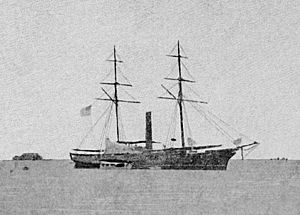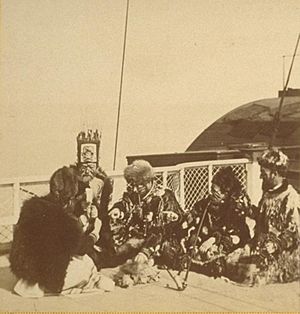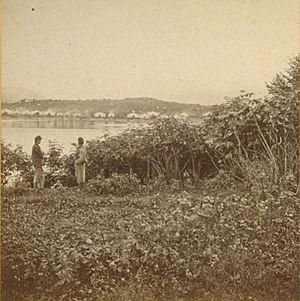Kake War facts for kids
Quick facts for kids Kake War |
|||||||
|---|---|---|---|---|---|---|---|
| Part of Department of Alaska | |||||||
 Sloop-of-war USS Saginaw |
|||||||
|
|||||||
| Belligerents | |||||||
| Commanders and leaders | |||||||
| Jefferson C. Davis Richard Worsam Meade |
Chief Tom | ||||||
| Units involved | |||||||
| USS Saginaw | Tlingit villagers | ||||||
| Strength | |||||||
| 1 Sloop-of-war | three villages and two wooden forts | ||||||
| Casualties and losses | |||||||
| 2 traders killed prior to conflict | 3 Tlingit killed and 5 wounded prior to conflict Possibly one killed in burning of villages An undetermined number of starvation deaths due to loss of winter suppliers |
||||||
The Kake War was a conflict in February 1869 in Alaska. During this event, the USS Saginaw destroyed three winter villages and two forts near what is now Kake, Alaska.
This happened after two white fur traders were killed by the Kake people. This act was in response to the deaths of two Kake people. They had been leaving Sitka by canoe. These deaths occurred during a tense situation between the U.S. Army and the Tlingit people in Sitka.
The destruction of their homes, food supplies, and canoes caused many Kake people to suffer. Some died from hunger or cold during the winter. The Kake people did not rebuild these small villages. Some moved to other villages, while others stayed and eventually rebuilt the modern-day Kake.
Contents
Understanding the Kake War's Origins
After the Alaska Purchase, the United States Army came to Alaska. They were in charge of governing the new Department of Alaska. The U.S. authorities followed common law, which was different from the traditional laws of the Tlingit people.
The Tlingit legal system was very old and complex. It often involved "peace ceremonies" to settle problems. These ceremonies could include giving goods or even lives as a way to make up for a wrong. Americans sometimes misunderstood this system.
Events Leading to the Conflict
On New Year's Day in 1869, three Tlingit chiefs were invited to Fort Sitka. They were going to meet with General Jefferson C. Davis. A guard at the fort stopped them. When they didn't follow his orders, he kicked one of the chiefs, Colchika.
Colchika took the soldier's rifle during the struggle. He then left the fort with it. When General Davis heard about this, he sent soldiers to the nearby Sitka village. He ordered them to bring Colchika back.
A fight broke out in the village. A Tlingit slave was killed, and Colchika and four others were hurt. The soldiers then left because they were outnumbered. General Davis then surrounded Sitka with a warship and fort cannons. He demanded that Colchika surrender. Some Tlingit people tried to leave Sitka by canoe, but they were shot by the warship.
After a few days, Colchika gave himself up to the Army. However, the next morning, an army guard killed two unarmed Kake Tlingit people. They were leaving Sitka in a canoe.
The Kake Seek Justice
Chief Tom of the Kake tribe asked General Davis for payment for the deaths. This was a custom in Tlingit law. General Davis refused to pay. Since they didn't get payment, the Kake people sought justice in another way.
The Kake captured four fur trappers on Admiralty Island. Two white trappers, Ludwig Madger and William Walker, were killed at Murder Cove. Two other guides, who were part Tlingit and part Russian, were allowed to go free.
Some people understood the Tlingit customs. Frank K. Louthan, a trader in Sitka, said that if an injury wasn't paid for, people would seek "an eye for an eye." The Kake people were following their traditions.
The Destruction of Kake Villages
When General Davis heard about the killings, he gave orders to Lieutenant Commander Richard Worsam Meade. Meade was in charge of the USS Saginaw. His orders were to sail to the Kake lands. He was to take some chiefs hostage until the people responsible for the killings surrendered. He was also ordered to burn the Kake villages. The Saginaw left on February 11, 1869.
A group of sailors from the Saginaw went ashore at Fossil Bluffs Village. They found it empty. The next day, they set it on fire. The Saginaw then sailed to Hamilton Bay, where present-day Kake is located. This was once a large village called Town Where No One Sleeps.
The ship fired cannons at this village before a landing party went ashore. They found the village empty and set it on fire. The next morning, the Saginaw sailed to Security Bay. There was another village there, now called Retaliation Point Village. It was also empty and was burned. The Saginaw then found two empty forts with supplies and smokehouses. These were also destroyed by fire.
According to stories passed down by the Kake people, one elderly woman stayed in Fossil Bluffs Village. She was tragically killed in the fire.
Aftermath and Recovery
The Kake people lost their winter food, canoes, and homes. This led to many deaths during the cold winter. The small villages that were destroyed were not rebuilt. Some Kake people moved to other villages. Others stayed near Kake and eventually rebuilt the community we know today.
Trade with Fort Sitka greatly decreased after the conflict. About five months later, a trader named Frank K. Louthan gave blankets and a coat to the Sitka and Chilkat people. This was worth about fifty dollars. He did this to help restart trade, as the army had refused to pay any compensation.
Years later, in the 1940s, an unexploded cannon shell was found by a Kake resident. It was stuck in a tree stump. This shell was from a Parrott rifle. It was kept as a family treasure for many years. In 2011, it was made safe and put on display at the Sealaska Heritage Institute.



